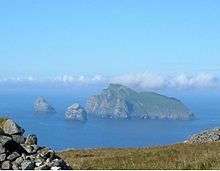Scalpay, Inner Hebrides
| Gaelic name | Sgalpaigh (an t-Sratha) |
|---|---|
| Norse name | Skalprøy[1] |
| Meaning of name | ship island[2] |
| Location | |
 Scalpay Scalpay shown relative to Skye | |
| OS grid reference | NG605315 |
| Physical geography | |
| Island group | Skye |
| Area | 2,483 ha (9.6 sq mi)[1] |
| Area rank | 32 [3] |
| Highest elevation | Mullach na Càrn 396 m (1,299 ft) |
| Administration | |
| Sovereign state | United Kingdom |
| Country | Scotland |
| Council area | Highland |
| Demographics | |
| Population | 4[4] |
| Population rank | 77= [3] |
| Pop. density | 0.16 people/km2[1][4] |
| References | [5] |
Scalpay (Scottish Gaelic: Sgalpaigh) is an island in the Inner Hebrides of Scotland.
Geography
Separated from the east coast of Skye by Loch na Cairidh, Scalpay rises to 396 metres (1,299 ft) at Mullach na Càrn. It has an area of just under 25 square kilometres (9.7 sq mi). The island had a population of ten usual residents in 2001[6] and of four in 2011.[4]
Scalpay is privately owned and operates a red deer farm, shooting estate and holiday cottages. Much of Scalpay is covered with heather, while other areas are conifer forestry plantations.
Etymology
Mac an Tàilleir (2003) suggests the name derives from "ship island" from the Norse.[2] However, Haswell-Smith states that the Old Norse name was Skalprøy, meaning "scallop island".[1]
History

Dean Monro gave the following description of Scalpay in 1549:
...a fair hunting forest, full of deer, with certain little woods and small towns, well inhabited and manured, with many strong coves, good for fishing, in heritage it pertains to Maclean of Duart.[7]
By the time of Dr Johnson's tour, the island was held by a tenant of Sir Alexander Macdonald.[8]
Shipping magnate and politician, Donald Currie owned the island in the late 19th century and was responsible for the construction of the first roads and much tree planting.
Footnotes
- 1 2 3 4 Haswell-Smith (2004) p. 153
- 1 2 Mac an Tàilleir (2003) p. 103
- 1 2 Area and population ranks: there are c. 300 islands over 20 ha in extent and 93 permanently inhabited islands were listed in the 2011 census.
- 1 2 3 National Records of Scotland (15 August 2013) (pdf) Statistical Bulletin: 2011 Census: First Results on Population and Household Estimates for Scotland - Release 1C (Part Two). "Appendix 2: Population and households on Scotland’s inhabited islands". Retrieved 17 August 2013.
- ↑ Ordnance Survey: Landranger map sheet 24 Raasay & Applecross (Loch Torridon & Plockton) (Map). Ordnance Survey. 2012. ISBN 9780319231104.
- ↑ General Register Office for Scotland (28 November 2003) Scotland's Census 2001 – Occasional Paper No 10: Statistics for Inhabited Islands. Retrieved 26 February 2012.
- ↑ Monro (1549) pp. 26-27
- ↑ Johnson (1795) p. 246
References
- Haswell-Smith, Hamish (2004). The Scottish Islands. Edinburgh: Canongate. ISBN 978-1-84195-454-7.
- Johnson, Samuel A Journey to the Western Islands of Scotland. London. Strachan and Cadell, 1785 (new edition).
- Mac an Tàilleir, Iain (2003) Ainmean-àite/Placenames. (pdf) Pàrlamaid na h-Alba. Retrieved 26 August 2012.
- Monro, Sir Donald (1549) Description of the Western Isles of Scotland. William Auld. Edinburgh - 1774 edition.
External links
Coordinates: 57°18′42″N 5°58′36″W / 57.31167°N 5.97667°W
